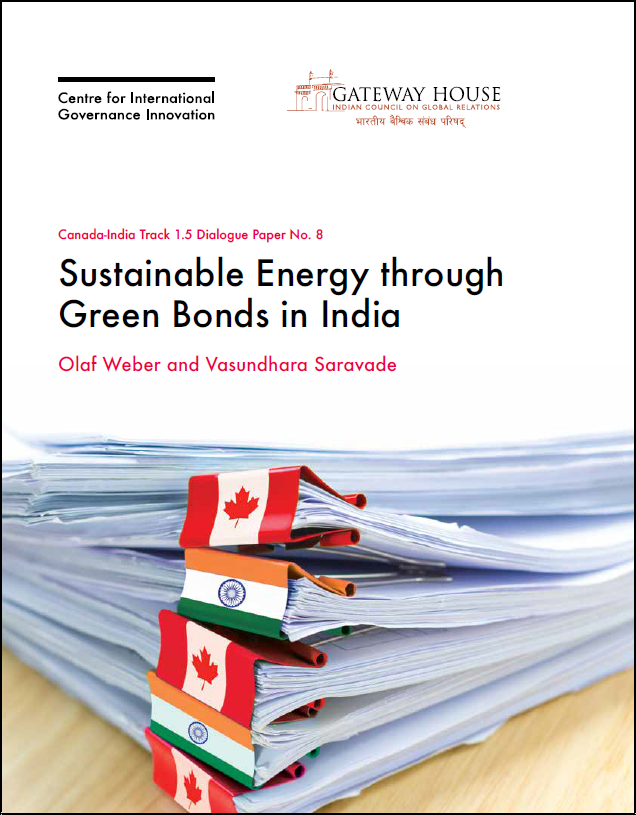The earth is warming rapidly. Currently, temperatures around 45o Celsius have been registered at the polar circle, though the average temperature in this region, at this time, is usually around 18o Celsius. Extreme weather events have become more frequent in both India and Canada, with devastating impacts on humans and the economy. With more than 70% of all Greenhouse Gas (GHG) emissions, the fossil-fuel burning, energy sector is one of the main drivers of climate change. Therefore, increasing the future use of green energy will be crucial to achieve global climate goals and to prevent a catastrophic climate change.
Though the main contributions to climate change can be clearly allocated to industrialized Western European and North-American countries, emerging economies, such as India, will need significant international investment in climate action in order to transition toward a future that is low-carbon and climate-resilient (LCR). As an emerging economy, India can attract greater foreign direct investment (FDI) through green bonds, a climate finance debt instrument that addresses environmental and climate-related challenges. Not only are green bond issuances linearly increasing over the years, but they also seem to be driven by institutional pressure, provided in part by the Securities and Exchange Board of India’s (SEBI’s) regulation, as well as by the informal advocacy efforts of market stakeholders.
Green bonds are a type of fixed-income instrument that raise funds for climate and environmental projects. These bonds are typically asset-linked and backed by the issuing entity’s balance sheet. Mostly, they have the same credit rating as their issuers’ other debt obligations. Global green bonds issuances were more than $ 250 billion in 2019, which is greater than the official development aid that flowed across borders. By the end of 2019, India had cumulatively issued about $10.3 billion in green bonds, whereas Canada had issued around $ 11.5 billion . Given the similar progress in the green bond markets by these two countries, our recommendations present some learnings for how market actors can tap into the cross-country potential of this market, and meet economic and political goals. These recommendations are also applicable for other countries trying to use their institutional norms to grow green finance.
Based on our research on green bonds, globally and in India, we firstly conclude that the institutional transition supporting green bonds is driven by high-priority social actors.

Social actors can play a key role in whether or not institutional pressure impacts the growth and potential of this market. For any institutional regime shifts, it is important to have them on board with the transition and help drive it to an extent. In the green bond market, social actors can range from formal institutions such as financial regulators and institutional investors to informal advocacy from industry groups such as the Federation of Indian Chambers of Commerce and Industry (FICCI) or the Climate Bonds Initiative (CBI).
A high priority social actor in this market is one that holds a high degree of legitimacy and financial power and spans various institutional settings. In India, these actors can be in the form of international investors which are looking to invest directly and fulfill green investment mandates, as well as important financial regulators such as the Reserve Bank of India (RBI) and SEBI, which are responsible for oversight and rule-setting in this market. However, the impact of these high-priority social actors, especially in terms of institutional change, is contingent on the level of global investor confidence and public perception of this market.
In other countries, such as China, several financial regulators play a strong role in the green bonds market. In China, certain institutional aspects such as lack of consistency of green bond definitions across regulators or their acceptance by international investors, can affect the perception of the green bond market. Therefore, it is integral that formal and informal rules for the green bond market be set by high priority social actors (including regulators and investors) that have a higher level of institutional legitimacy and broader reach. For instance, Indian regulators such as SEBI and RBI, can not only ensure widespread participation in decision-making from domestic investors and issuers in India, but also tap into the technical expertise that is available at the international level from advocacy groups such as the CBI or FICCI.
Secondly, collaboration among these high priority social actors also tends to lead to better outcomes. Our findings indicate that cooperation among various regulators can lead to improved harmonization across policies, which has a positive impact on this market. A lack of collaboration can adversely impact the effectiveness of a policy or legitimacy of this market. Although currently there are interdepartmental committees in India set up by regulators on green finance, new regulators such as the Pensions Fund Regulatory and Development Authority, and the Insurance Regulatory and Development Authority of India, may issue regulations relating to this market at some point. Given that these regulators also have public mandates, the central government should take on the role of policy coordinator and ensure that global institutional investors perceive India’s green bond market to be ready for investment.
Thirdly, the reduction of high priority social actors’ perceived risk can contribute to institutional strength. To reduce regulatory risk, it is important that high-priority social actors such as institutional investors and green bond issuers are kept informed on regulatory changes. Therefore, having a public forum or platform can be an important tool for better communication among various social actors. Although there are some communication initiatives, such as the Indian Green Bond Council, it is important that regulators be easily accessible to primary market players.
Green bond issuances in India provide opportunities for Canada and its major institutional investors to increase green FDI and mitigate the climate risks of their investments in India. It offers a unique opportunity because Indian green bonds are issued in foreign currencies such as the U.S. dollar as well as the Indian rupee; this allows foreign investors to fulfill their diversification quotas as well as meet stakeholder demands on green investments. In contrast, China’s green bond market mostly caters to domestic investors and has previously been a limitation for investors looking to avoid controversial projects such as clean coal.
Given the large number of institutional investors such as pension funds based in Canada, that want to fulfill their fiduciary duties of long-term fast-growing financial returns, we suggest that investing in an emerging market such as India’s green bonds market can be a way forward.
Capital from these investors can drive domestic green projects in India which in turn offer business opportunities for Canadian clean technology companies to export their products, services or expertise to India. In particular, sectors such as renewable energy and low-carbon transport such as rail can be transformative for both Indian and Canadian companies. They can comply with the Indian government’s mandate of providing clean electricity and low-carbon connectivity, and fill the current financing-gap for such projects due to the asset-liability mismatch in India’s financial sector.
Olaf Weber is Senior Fellow, Centre for International Governance Innovation (CIGI), Canada & University of Waterloo Research Chair in Sustainable Finance, Professor & Associate Director of Graduate Studies.
Vasundhara Saravade is Research Assistant, University of Waterloo.
This article was exclusively written for Gateway House: Indian Council on Global Relations. You can read more exclusive content here.
For interview requests with the author, or for permission to republish, please contact outreach@gatewayhouse.in.
© Copyright 2020 Gateway House: Indian Council on Global Relations. All rights reserved. Any unauthorized copying or reproduction is strictly prohibited.


